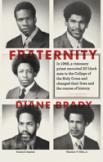Integrating Holy Cross
At the end of the 1960s, a Jesuit priest trained in theology decided the time was ripe for the College of the Holy Cross to embrace the spirit of the Second Vatican Council and social change. Propelled by the assassination of Martin Luther King Jr., John Brooks, S.J., took it on himself to integrate what for years had been a shining example of a launching pad for the Irish Catholic aristocracy.
Brooks, backed by the president of Holy Cross, Raymond Swords, S.J., drove to Philadelphia to recruit as many passionate, smart African-American high school seniors as he could afford. The collection of 20 men he helped bring to Worcester, Mass., in the summer of 1968 was remarkable. Fraternity, a book by Diane Brady of Bloomberg BusinessWeek, tells the stories of five of them.
Two of them, Clarence Thomas, now a U.S. Supreme Court justice, and Ted Wells, a federal defense attorney from New Jersey who represents high-level government officials accused of wrongdoing, have made their mark in American law. Ed Jenkins played for the Miami Dolphins in their undefeated 1972 season. Ed Jones won the Pulitzer Prize for fiction in 2004 for his novel The Known World, and Stanley Grayson served as a deputy mayor of New York City before becoming president of M. R. Beal & Co., one of the nation’s largest minority-owned investment banks.
Brooks did not act alone in changing the face of Holy Cross. Wells, for example, was an outstanding Washington, D.C., center recruited by the football coach. Wells had already made a commitment to Pittsburgh, but a call from Edward Bennett Williams, then a part owner of the Washington Redskins as well as a nationally known lawyer and Holy Cross alumnus, helped change his mind.
Grayson, from Detroit, was recruited as a basketball player. And a tour of the campus with Art Martin, one of eight black students at Holy Cross at the time, helped convince him that he could thrive there.
For readers unfamiliar with Thomas’ memoirs, My Grandfather’s Son (Harper Collins, 2007), Fraternity does a good job of tracing his path from high school in a Roman Catholic seminary to graduation as ninth in his class at Holy Cross. He was instrumental in forming the Black Students Union, developed to present the students’ perspective to the college administration. Among other extracurricular activities, Thomas wrote for the student paper, The Crusader.
Most of the book is devoted to Brooks’s mentoring of the African- American students and examining the role the Black Students Union played in campus life. The focal point came in December 1969. Antiwar fever ran high, especially on college campuses, where the student deferment for the Vietnam draft had been replaced by the first selective service lottery system. Around the country, recruiters from companies tied to the war effort were subjected to protests. Holy Cross was no exception.
A group of about 50 students, most of them members of the Revolutionary Students Union, locked arms to block any meeting with the career counselors. The dean of students was livid. His staff identified 16 of the students involved, four of them black. There were only five blacks at the protest. At a meeting of the College Judicial Board, Wells spoke for the black students, pointing out the racism of the decision to charge 80 percent of the blacks at the protest, because they were easily identifiable, while letting 80 percent of the whites walk away. The board ordered the 16 students expelled.
The black students determined that to make their point, they would have to leave Holy Cross. But the administration was determined that the college had invested too much energy in its drive for integration to let it fall apart. By the time the Christmas break ended, the administration had found a way out.
Brady does a good job describing this conflict and other hurdles the college and students faced during a tumultuous time in American history. If there is a weakness in the narrative, it is the lack of voices. We never hear, for example, what white students at Holy Cross thought about Brooks’s crusade. Though the author thanks all the participants for their cooperation with her research, Fraternity is woefully lacking in direct quotations. Brady tells us what it was like to be among the black students at Holy Cross at the end of the 1960s, but she doesn’t show us.
This article also appeared in print, under the headline “Integrating Holy Cross,” in the April 30, 2012, issue.








